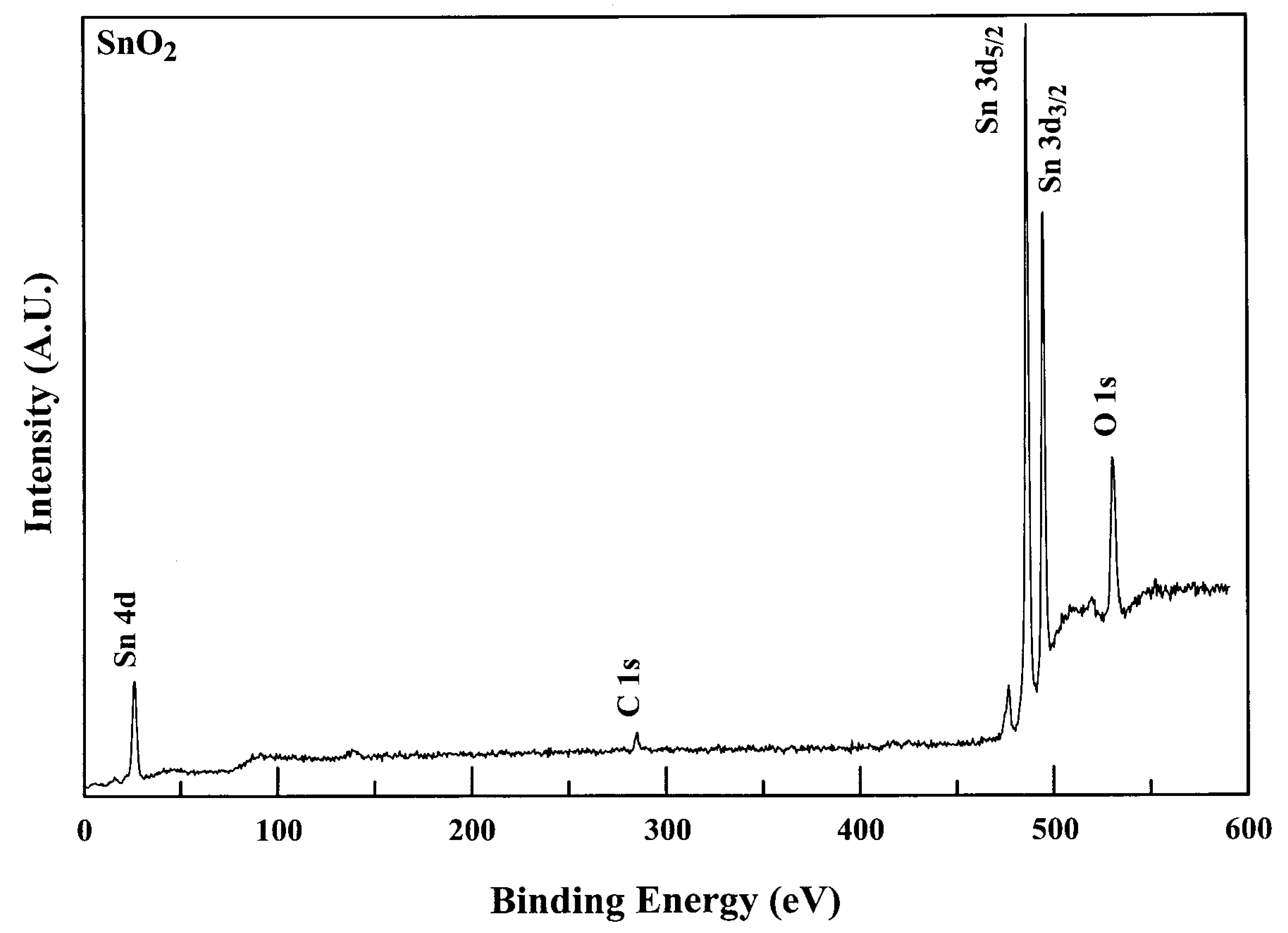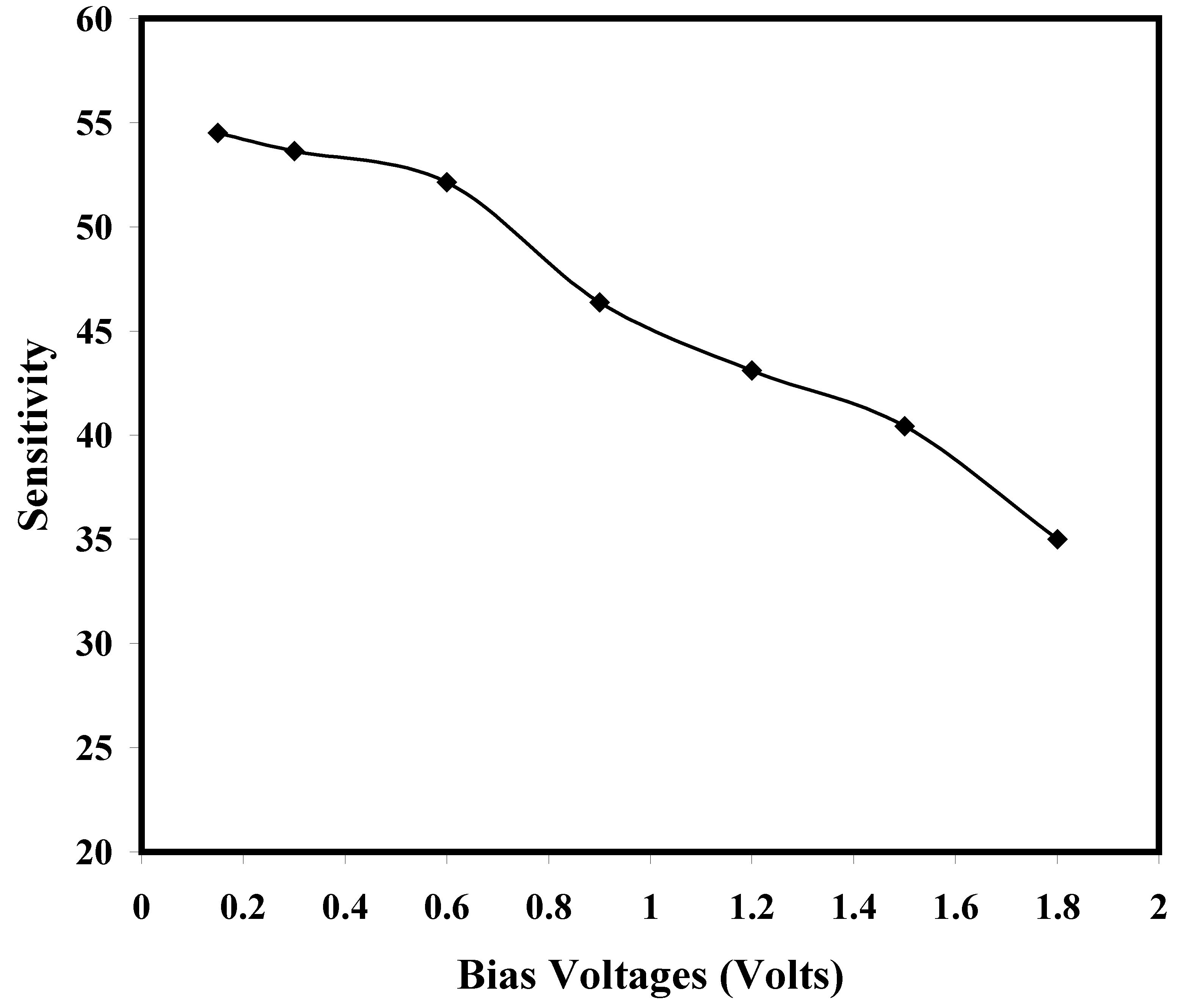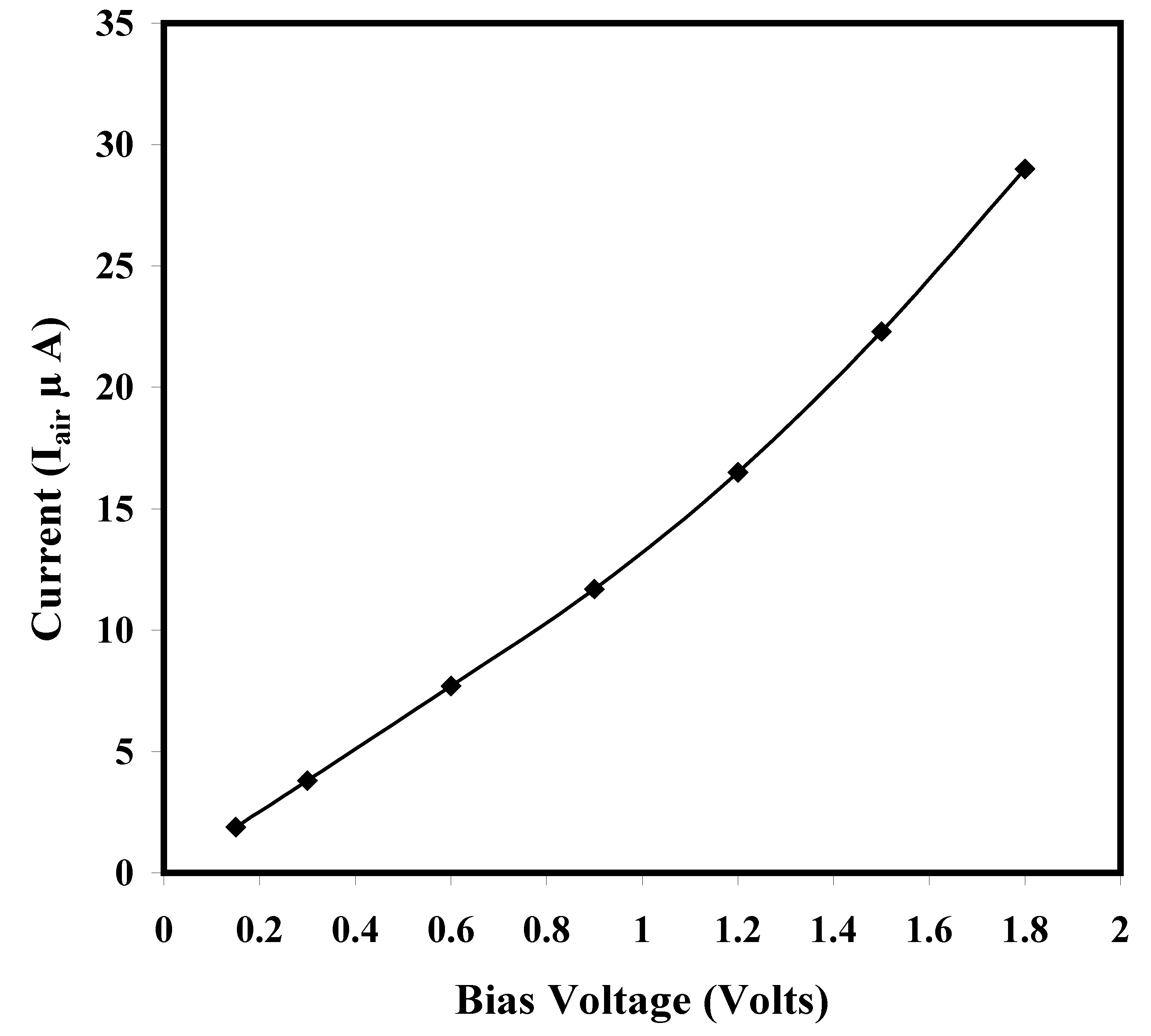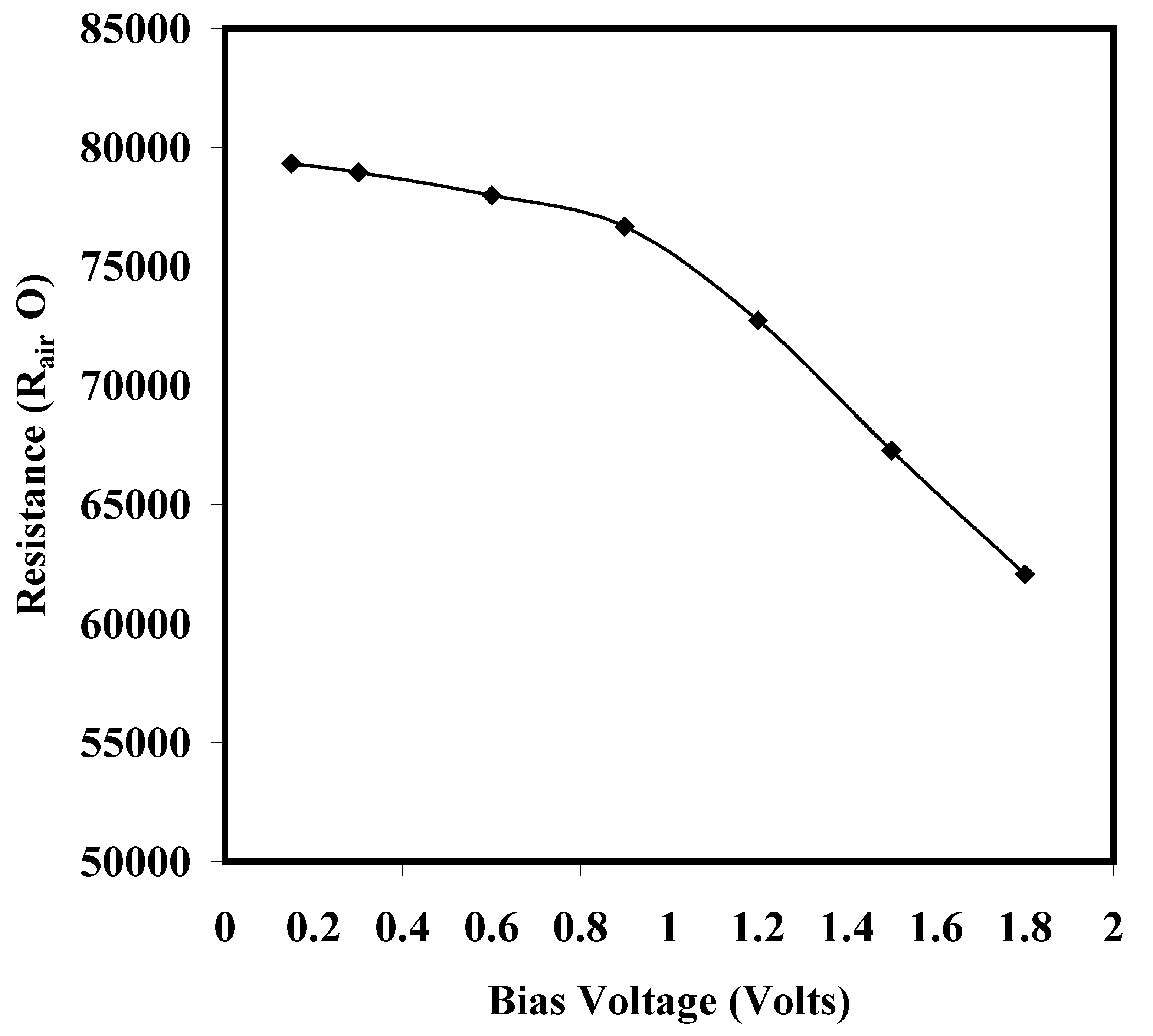Biasing Voltage Dependence of Sensitivity of Electron Beam Evaporated SnO2 Thin Film CO Sensor
Abstract
:1. Introduction
2. Experimental Details
3. Results and Discussion
3.1 Characterization of films

3.2 CO gas-sensing properties



Conclusions

Acknowledgments
References
- Durrani, S. M. A.; Al-Kuhaili, M. F.; Khawaja, E. E. CO-sensing properties of undoped and doped tin oxide thin films prepared by electron beam evaporation. Talanta 2005, 65, 1162–1167. [Google Scholar] [CrossRef] [PubMed]
- Wurzinger, O.; Reinhardt, G. CO-sensing properties of doped SnO2 sensors in H2-rich gases. Sensors and Actuators 2004, B103, 104–110. [Google Scholar] [CrossRef]
- Mandayo, G. G.; Castano, E.; Gracia, F.J.; Cirera, A.; Cornet, A.; Morante, J.R. Strategies to enhance the carbon monoxide sensitivity of tin oxide thin films. Sensors and Actuators 2003, B95, 90–96. [Google Scholar] [CrossRef]
- Matko, I.; Gaidi, M.; Hazemann, J. L.; Chenevier, B.; Labeau, M. Electrical properties under polluting gas (CO) of Pt- and Pd-doped polycrystalline SnO2 thin films: analysis of the metal aggregate size effect. Sensors and Actuators 1999, B59, 210–115. [Google Scholar] [CrossRef]
- Sharma, R. K.; Chan, P. C. H.; Tang, Z.; Yan, G.; Hsing, I. M.; Sin, J. K. O. Sensitive, selective and stable tin dioxide thin-films for carbon monoxide and hydrogen sensing in integrated gas sensor array applications. Sensors and Actuators 2001, B72, 160–166. [Google Scholar] [CrossRef]
- Becker, Th.; Ahlers, S.; Bosch-v. Braünmuhl, Chr.; Müller, G.; Kiesewetter, O. Gas sensing properties of thin- and thick-film tin-oxide materials. Sensors and Actuators 2001, B77, 55–61. [Google Scholar] [CrossRef]
- Montmeat, P.; Marchand, J-C; Lalauze, R.; Viricelle, J-P; Tournier, G.; Pijolat, C. Physico-chemical contribution of gold metallic particles to the action of oxygen on tin dioxide sensors. Sensors and Actuators 2003, B95, 83–89. [Google Scholar] [CrossRef]
- Mishra, V. N.; Agarwal, R. P. Effect of electrode material on sensor response. Sensors and Actuators 1994, B22, 121–125. [Google Scholar] [CrossRef]
- P. Dutronc, B.; Carbonne, F.; Menil, C. Lucat, Influence of the nature of the screen-printed electrode metal on the transport and detection properties of thick-film semiconductor gas sensors. Sensors and Actuators 1992, B 6, 279–284. [Google Scholar] [CrossRef]
- Durrani, S. M. A. The influence of electrode metals and its configuration on the sensitivity of tin oxide thin film CO sensor. Talanta 2006, 68, 1732–1735. [Google Scholar] [CrossRef] [PubMed]
- Khawaja, E. E.; Bouamrane, F.; Hallak, A. B.; Daous, M. A.; Salim, M. A. Observation of oxygen enrichment in zirconium oxide films. J. Vac. Sci. Tech. 1993, A11, 580–587. [Google Scholar] [CrossRef]
- Vink, T. J.; Verbeek, G. F. A.; Snijders, J. H. M.; Tamminga, Y. Physically trapped oxygen in sputter-deposited MoO3 films. J. Appl. Phys. 2000, 87, 7252–7254. [Google Scholar] [CrossRef]
- Al-Kuhaili, M. F.; Durrani, S. M. A.; Khawaja, E. E. Optical Properties of Hafnium Oxide Films Prepared by Electron Beam Evaporation. J. Phys. D: Appl. Phys. 2004, 37, 1254–1261. [Google Scholar] [CrossRef]
- Becker, Th.; Ahlers, S.; Bosch-v.Braunmühl, Chr.; Müller, G.; Kiesewetter, O. Gas sensing properties of thin- and thick-film tin-oxide materials. Sensors and Actuators 2001, B77, 55–51. [Google Scholar] [CrossRef]
- Akbar, S. A.; Younkman, L. B. Sensing mechanism of a titania-based CO sensor. J. Electrochemical Society 1997, 144, 1750–1753. [Google Scholar] [CrossRef]
- Shimizu, Y.; Nakamura, Y.; Egashira, M. Effect of diffusivity of hydrogen and oxygen through pore of thick film SnO2-based sensor on their sensing properties. Sensors and Actuators 1993, B13, 128–131. [Google Scholar] [CrossRef]
© 2006 by MDPI (http://www.mdpi.org). Reproduction is permitted for noncommercial purposes.
Share and Cite
Durrani, S.M.A. Biasing Voltage Dependence of Sensitivity of Electron Beam Evaporated SnO2 Thin Film CO Sensor. Sensors 2006, 6, 1153-1160. https://doi.org/10.3390/s6091153
Durrani SMA. Biasing Voltage Dependence of Sensitivity of Electron Beam Evaporated SnO2 Thin Film CO Sensor. Sensors. 2006; 6(9):1153-1160. https://doi.org/10.3390/s6091153
Chicago/Turabian StyleDurrani, Sardar M. Ayub. 2006. "Biasing Voltage Dependence of Sensitivity of Electron Beam Evaporated SnO2 Thin Film CO Sensor" Sensors 6, no. 9: 1153-1160. https://doi.org/10.3390/s6091153



